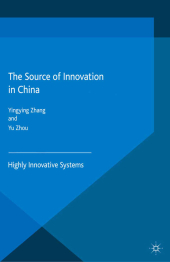 Neuerscheinungen 2015Stand: 2020-02-01 |
Schnellsuche
ISBN/Stichwort/Autor
|
Herderstraße 10
10625 Berlin
Tel.: 030 315 714 16
Fax 030 315 714 14
info@buchspektrum.de |

Y. Zhang, Y. Zhou
(Beteiligte)
The Source of Innovation in China
Highly Innovative Systems
Herausgegeben von Zhang, Y.; Zhou, Y.
1st ed. 2015. 2015. xxiv, 253 S. 216 mm
Verlag/Jahr: SPRINGER PALGRAVE MACMILLAN; PALGRAVE MACMILLAN UK 2015
ISBN: 1-349-46286-1 (1349462861)
Neue ISBN: 978-1-349-46286-5 (9781349462865)
Preis und Lieferzeit: Bitte klicken
Given the most popular understanding of Chinese comparative advantage is their low labour cost, The Source of Innovation in China argues the fundamental source for Chinese economic growth is its innovation. Based on case studies and surveys collected from 600 firms, this book describes competitive advantages of successful Chinese enterprises.
1. The Rise of China: Innovation or Cost Leader 2. Chinese Innovation in Product, Process and Strategy 3. Chinese Culture and Value: Enhancing or Impeding Innovation? 4. Network-based Innovation in China: Typology Along with Economic Evolution 5. People-centric Innovation: Strategic HR Management and Innovation 6. Innovation Challenge when Multinationalizing: The Source for Innovation
After a glorious past of innovation second to none, China lost the train of the Industrial Revolution and had to pay dearly with the "century of humiliation". The lesson has been learned. One of the key factors of China s galloping economic development of the last third of a century is the leadership´s obsession with science, technology and education. Deng Xiaoping considered technology the main factor of production. Besides, China knows that to escape the "middle income trap" it has to move towards a knowledge economy. Against conventional wisdom, Yingying Zhang and Yu Zhou shows that it is innovation, along with low-cost, that underpins China s economic development. They defines the sources and strategic focus of Chinese innovation, and emphasizes the relevance of cultural factors. The speed of China s catching-up in science and technology will determine the pace of its economic growth, of its penetration of international markets and of its transformation into a true great power.
Eugenio Bregolat, Former Ambassador of Spain in China and Author of The Second Revolution in China
The thesis of this book is that China´s economic success is based on innovation, rather than inexpensive labor. Expectations that China´s economic rise will stall due to rising labor costs thus may be misplaced. An incremental innovation dynamic identified by the authors, spread widely through industries at different levels of technology, suggests that China´s economy can sustain higher wages but can it take global leadership in innovation? Rather than relying on technology transfer for access to advanced technology, can China produce more fundamental forms of innovation that derive from university-industry government (triple helix) interactions based on an open Civil Society?
Henry Etzkowitz, President Triple Helix Association (THA), visiting Professor at London University and Edinburgh University, UK
Manufacturing development in China is on the ground of three advantages: low-cost human resources, cheap raw material availability and direct support from the government. However, if we deny the considerable innovative capacity of enterprises in China and if we accept that innovation is the key factor for economic growth in a region/country, it is a real paradox that a country has weak innovation but high value of increasing rate of the GDP. This volume, basic on a broad innovation definition and affirmation of China´s innovation capability, tries to explain the source of the innovation capacity as the result of the government having implemented innovation strategy for recent decades. It squares up the humanistic factors such as strategy, culture and social network, highlighting China´s specific characteristics in innovation.
Chunyan Zhou, Editor for Journal of Knowledge-based Innovation in China (2011-2013)


